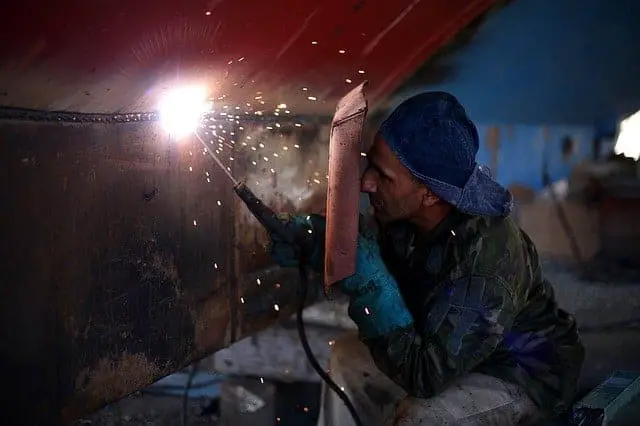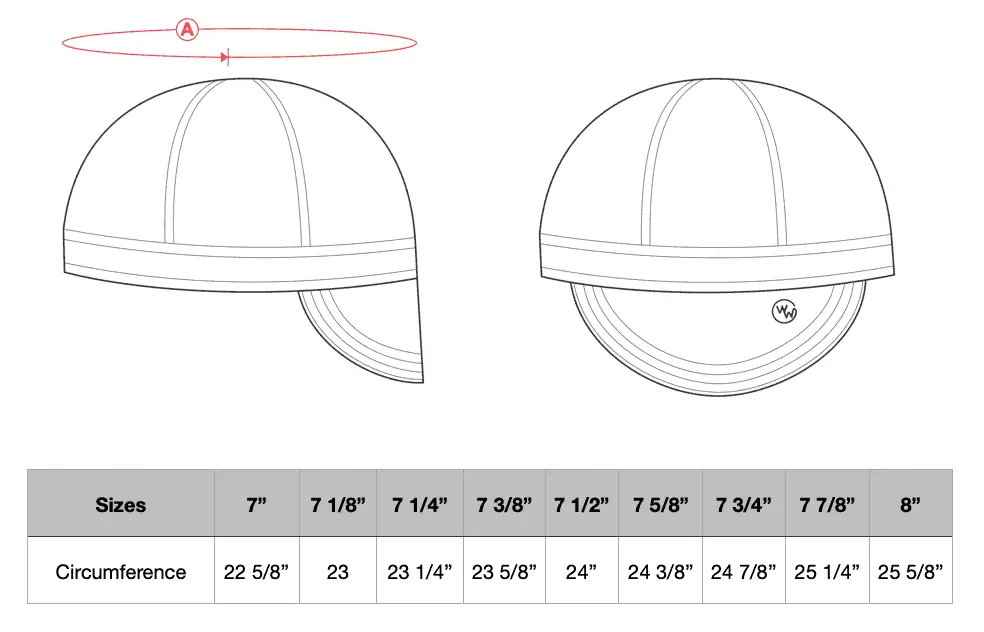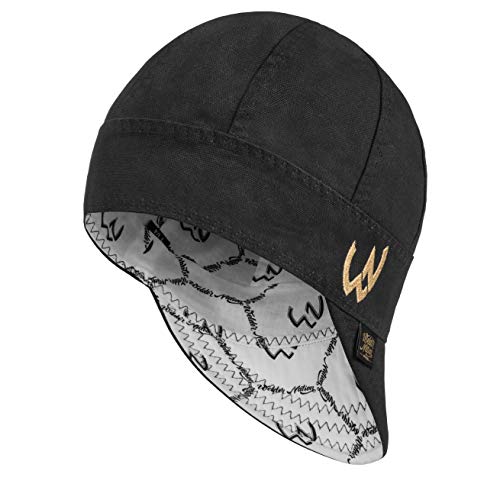If you spend the most of your time doing wedding work surrounded by flying sparks, you will undoubtedly want a welding hat to protect your head.
Choosing the proper material for the welding cap goes a long way toward ensuring your comfort and giving you good value for your money.
Normally, the welding hat is composed entirely of cotton. Wearing synthetic fabric caps like nylon or polyester near hot tasks, such as welding, is never a good idea, because they do not breathe properly, they will be more comfortable in the winter than in the summer as casual wear.
Here are reasons why cotton is a great fabric for welding caps-
1.) To begin with, cotton is fire-resistant. When the material lands on your head or neck, it emits fire sparks.
Furthermore, fabric designers stitch the cotton strands in a permeable way that permits airflow. Polyester and nylon materials, on the other hand, are flammable and poor absorbers.
2.) Secondly, cotton is absorbent and will prevent sweat from accumulating on your skin as you work. This function is essential since you will be working in hot temperatures that will cause you to sweat.
Reasons why you need to use a welding cap
1.) Safety
The main reason for wearing a welding cap is to protect your scalp, hair, eyes, ears, and neck from flying sparks that can cause burns and extreme pain.
Cotton is a flame-retardant substance. It prevents any sparks from starting a fire, which would otherwise burn your hair and skin.
When you get a high-quality welding cap, you will not only protect yourself from sparks, but you will also be well-insulated against extreme cold while working.
2.) Padding/cushioning for your head
Wearing a welding cap serves the primary goal of shielding the welder’s head, ears, and neck from flying sparks.
While you’ll still need a face shield and a welding helmet to protect your eyes and face, a welding cap might aid to cushion your head.
Aside from cushioning, the hat protects against UV radiation produced during welding as well as direct sunlight.
3.) Comfort
Welding is a trade that requires a lot of heat and can cause a lot of perspiration and pain. Sweat may stream down your face and into your eyes, neck, and back, producing blurred vision and itching.
The welding cap is made of an absorbent substance. The fabric wicks away perspiration, leaving you dry and cool. The cap is also made of breathable material, which allows wind to cool your scalp and ears.
Furthermore, the cap cloth functions as a cushion, shielding the body from the discomfort produced by the metal used to build the helmet. Wearing the hat under the helmet keeps it in place and prevents it from falling off.
4.) Flame retardant/heat retardant qualities
Welding caps are made with heat-resistant materials to keep your head safe from high temperatures.
They are also thick enough to keep slag and spatter from entering and scorching your skin, which is very important when performing a lot of overhead work.
Furthermore, most caps have a sweatband to assist absorb sweat and drain moisture away so it doesn’t get in your way while working.
5.) Side flaps
Some hats contain flaps that allow the cap to adjust to the contour of your head. For individuals with long hair, the flap provides a place to tuck it in.
Because high temperatures and sparks can harm your hair, wearing a hat can protect your hair from burns and damage.
These flaps serve to protect not only your head, but also your neck and collar area. The enlarged flaps, in theory, enhance the head area covered when welding.
Things to consider before purchasing a welding cap
When it comes to selecting the best welding caps, there are a few factors to consider before making a purchase. Let’s have a look at some of the things you should think about:
1.) Types: They come in a variety of styles such as beanie caps, skull caps, baseball caps, rag caps, and so on. Choose a welding cap that meets our specifications and complements your personal style the best.
2.) Sizes: Make certain that it fits nicely on your head. Because, at the end of the day, you don’t want to be wearing a cap that is too loose or too tight on your head, since this might be uncomfortable while working and may cause hindrance.
3.) Materials: As we have already discussed above, it is critical to evaluate the materials from which the welding cap is produced, as cotton-based caps are quite pleasant and readily absorb perspiration away.
Cotton is also permeable, but polyester is not and does not have the absorbent ability that cotton possesses.
4.) Flexibility
Most caps may be adjusted to sit differently on the head based on the welding need. For example, if you’re welding something overhead, you’ll want to shield your head and neck from falling sparks. In this case, you must adjust the cap such that the flaps are at the back of your head.
Similarly, if you are welding on a one-sided angle, you should shield your chin and ear that is facing the machine. In this scenario, a cap that can be flipped to the side will be useful.
How to find the perfect size of your welding cap?
Welding caps are available in a variety of forms, styles, and sizes. Some have a high crown, while others have a broad crown, similar to non-welding caps. Others merely cover the head, while others extend down to the neck and collar region.
To find a proper fit, follow these steps:
1.) Using a measuring tape, check the diameter of your head.
2.) Make sure the measuring tape is on the part of your head where the hat will fit. It shouldn’t be too tight or too loose.
3.) Remove the tape and make a record of the measurements. Take the circumferential length and measure it against a measuring tape, then write down the number of inches for the string.
4.) Put the measuring tape or string at the highest part of your head and move it down to where you want the bottom band to lay on your skull to approximate the crown height.
5.) You may also determine the crown height by wearing another hat that fits you properly.
6.) Based on your measurements, a local welding cap merchant will assist you in selecting the best fitting hat. If you purchase online, you can discover a comparison chart to help you choose the best size.
Note- Your cotton welding cap will probably shrink after the first wash, therefore, you need to consider the sizing before making a purchase.
FAQs-
Can you make your own welding cap?
Well yes, you can go ahead and make your own welding cap provided you follow proper instructions. Here is a video that tells you everything about making your own DIY welding cap-
Can you use regular caps for welding?
No, it is not advisable to use any other regular caps while welding because welding caps are properly made keeping a welder’s work in mind.
They are of a specific material and design which offers a certain level of protection that a normal cap won’t provide.
Recommended Welding Caps for You
1.) REVCO Cotton Welding Cap
- Bc5w-bk bsx armor cotton welding cap, 100% cotton double layer protection
- Welding cap, doo rag and beanie - all in one
- One size fits all
- Package dimensions : 1.0 inches (H) x 5.0 inches (L) x 4.0 inches (W)
Prices pulled from the Amazon Product Advertising API on:
Product prices and availability are accurate as of the date/time indicated and are subject to change. Any price and availability information displayed on [relevant Amazon Site(s), as applicable] at the time of purchase will apply to the purchase of this product.
Composed of 100% cotton and ensuring a breathable and self-cooling cap, this cap is very reliable when it comes to your welding work.
It is also simple to put on because of the re-adjustable elastic headband, which conforms to the shape and size of your head.
2.) Welder Nation Welding Cap
- This very durable yet soft 10 oz. cotton canvas is known for how long it lasts and withstanding heavy use.
- Exterior of cap is made with duck canvas and lined inside with comfortable cotton.
- THE IDEAL FIT – No unicorn peak at the front and 10 available sizes. 7 ½” deep crown.
- TRIED & TRUE - Stands up to extreme working conditions.
Prices pulled from the Amazon Product Advertising API on:
Product prices and availability are accurate as of the date/time indicated and are subject to change. Any price and availability information displayed on [relevant Amazon Site(s), as applicable] at the time of purchase will apply to the purchase of this product.
This hat is one of the most effective welding caps available. It is also composed of 100% cotton fabric, which makes it breathable for easy air circulation.
There are extra flaps to cover the eyes, ears, and neck.
3.) Lincoln Electric Welding Cap
- HIGH QUALITY COTTON
- SWEAT ABSORBANT LINER
- FLAT STITCHED SEAMS
- LIGHTWEIGHT & BREATHABLE
- ELASTIC FIT
- USED BY PROFESSIONALS
Prices pulled from the Amazon Product Advertising API on:
Product prices and availability are accurate as of the date/time indicated and are subject to change. Any price and availability information displayed on [relevant Amazon Site(s), as applicable] at the time of purchase will apply to the purchase of this product.
It is flame resistant and constructed of 100% cotton for breathability. Can be washed easily and is super absorbent.
4.) Comeaux Reversible Welding Cap
- Comeaux Caps Welding hat
- Size 7 1/4
- Solid Black
- 100% Cotton
- 6 panel Cap
Prices pulled from the Amazon Product Advertising API on:
Product prices and availability are accurate as of the date/time indicated and are subject to change. Any price and availability information displayed on [relevant Amazon Site(s), as applicable] at the time of purchase will apply to the purchase of this product.
The fabric is made entirely of cotton, which allows for perspiration absorption and a cooling effect. You may also reverse them to cover any part of your head you choose.
Conclusion
Since we know that welding caps are an integral part of your safety while welding, the material with which it is made is also important.
Caps made of synthetic fabric will not be suitable, therefore, cotton is the most ideal fabric for welding caps.













